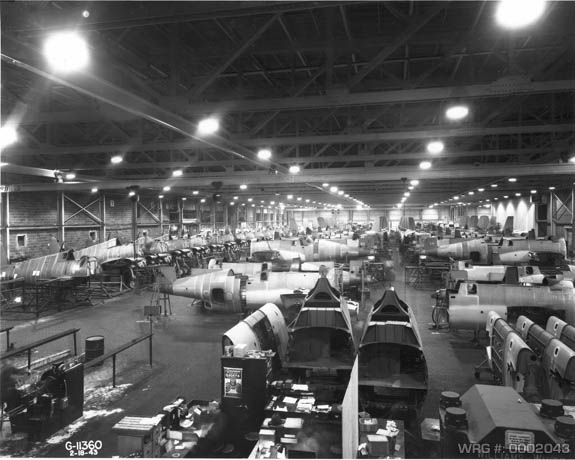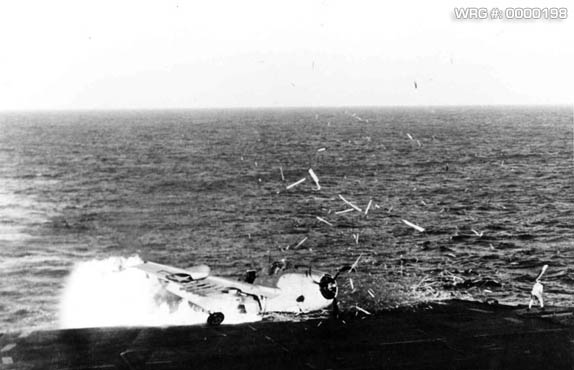U.S. NAVAL AVIATION RESOURCE CENTER > BOMBERS > PREVIOUS PAGE
Grumman TBF Avenger
Design & Development
Introduced in 1935 the U.S. Navy's main torpedo bomber, Douglas' TBD Devastator, was obsolete by 1939 and a replacement was needed. Bids were accepted from several companies but Grumman's TBF design was selected as the TBD's replacement and two prototypes were ordered by the Navy in April 1940. Designed by Leroy Grumman, the first prototype was called the XTBF-1. It was first flown on August 1, 1941. Although one of the first two prototypes crashed near Brentwood, New York, rapid production continued.

Grumman Hellcat and Avenger fuselages being built, February 18, 1943
[Source: Grumman Archives]
Grumman's first torpedo bomber was the heaviest single-engine aircraft of World War II, and only the USAAF's d weight among all single-engined fighters, only being some 400 lb (181 kg) lighter than the TBF, by the end of World War II. The Avenger was the first design to feature a new "compound angle" wing-folding mechanism created by Grumman, intended to maximize storage space on an aircraft carrier; the F4F-4 and later models of Wildcat received a similar folding wing and the F6F Hellcat (both designed by Grumman)
employed this mechanism as well. The engine used was the Wright R-2600-20 Cyclone 14 twin-row radial engine (which produced 1,900 hp/1,417 kW). The aircraft took 25 gallons of oil and used one gallon per minute at start-up. There were three crew members: pilot, turret gunner and radioman/bombardier/ventral gunner. One .30 caliber machine gun was mounted in the nose, a .50 caliber gun was
mounted right next to the turret gunner's head in a rear-facing electrically powered turret, and a single .30 caliber hand-fired machine gun mounted ventrally (under the tail), which was used to defend against enemy fighters attacking from below and to the rear. This gun was fired by the radioman/bombardier while standing up and bending over in the belly of the tail section, though he usually sat on a folding bench facing forward to operate the radio and to sight in bombing runs. Later models of the TBF/TBM dispensed with the nose-mounted gun for one .50 caliber gun in each wing per pilots' requests for better forward firepower and increased strafing ability. There was only one set of controls on the aircraft, and no access to the pilot's position from the rest of the aircraft. The radio equipment was massive, especially by today's standards, and filled the whole glass canopy to the rear of the pilot.
The radios were accessible for repair through a "tunnel" along the right hand side.
The Avenger had a large bomb bay, allowing for one Bliss-Leavitt Mark 13 torpedo, a single 2,000 pound (907 kg) bomb, or up to four 500 pound (227 kg) bombs. The aircraft had overall ruggedness and stability, and pilots say it flew like a truck, for better or worse. With its good radio facilities, docile handling, and long range, the Grumman Avenger also made an ideal command aircraft for Commanders, Air Group (CAGs). With a 30,000 ft (10,000 m) ceiling and a fully loaded range of 1,000 mi (1,610 km), it was better than any previous American torpedo bomber, and better than its Japanese counterpart, the obsolete Nakajima B5N "Kate". Later Avenger models carried radar equipment for the ASW and AEW roles. Although improvements in new types of aviation radar were soon forthcoming from the engineers at MIT and the electronic industry, the available radars in 1943 were very bulky, because they contained vacuum tube technology. Because of this, radar was at first carried only on the roomy
TBF Avengers, but not on the smaller and faster fighters.

May 25, 1944- pieces of the wooden flight deck of the escort carrier Solomons (CVE 67) fly after a TBF Avenger flown by William F. Chamberlin comes up short while attempting to land. He and his two crewmen survived.
[Source: U.S. Navy Photo]
Escort carrier sailors referred to the TBF as the "turkey" because of its size and maneuverability in comparison to the F4F Wildcat fighters in CVE airgroups.
Sources:
Wikipedia
U.S. NAVAL AVIATION RESOURCE CENTER > BOMBERS > PREVIOUS PAGE


